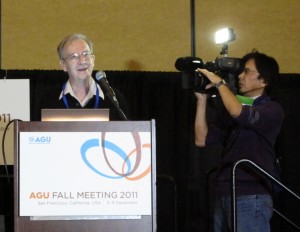Yakutat time, correcting some errors, big meeting in San Francisco
November 29, 2012

Ned Rozell
11/29/2012
A few people contacted me after a column I wrote on time zones a while back. Flip Todd of Anchorage called to say Yakutat clocks displayed a different time than those anywhere else in Alaska prior to 1983. Back then, before Alaska went to the current two-time-zone system, Yakutat followed Yukon time, one hour removed from both Juneau and Anchorage. Flip also corrected my misspelling, in a later column, of the Takotna River.
Peter Montesano wrote that once while he was living in Newfoundland he pulled out a map and noticed that North America has nine time zones. Having visited the western Aleutians and the seven time zones that spread eastward from it, Montesano felt compelled to take a boat ride to the islands of St. Pierre and Miquelon, just south of Newfoundland. While he was visiting what a Wikipedia writer described as the “self-governing territorial overseas collectivity” of France, Montesano’s watch, set to Newfoundland time, was one-half hour behind.
In St. Pierre, Montesano enjoyed some French cuisine.
“St. Pierre and Miquelon are windswept with much exposed rock like Newfoundland,” he said. “But instead of fish and chips it has patisseries, fine wines, Peugeots and Renaults.”
Montesano wonders if anyone else has visited all nine time zones in North America.
“I have always considered the continent relatively metropolitan, but this has left me thinking we are quite provincial,” he said.
The important take-away message here is to remember if you are eating lunch in Adak at noon and decide to call your friend in Saint Pierre, you will interrupt his 7 p.m. dinner.
Regarding a recent column I wrote on the death of glaciologist and photographer Austin Post, Ross Coen corrected me on the year (1957) that Post’s friend Dick Hubley died on McCall Glacier in the Brooks Range. In a sad event that followed publication of the Austin Post column, Mark Meier died on November 25, 2012. Meier, who one week earlier shared over the phone with me thoughts of his late friend Austin Post and the opportunities to which he steered the brilliant high-school dropout, was 86. Meier was director emeritus of the University of Colorado’s Institute of Arctic and Alpine Research.
Next week, thanks again to the director of the Geophysical Institute, I’ll be attending my 14th consecutive Fall Meeting of the American Geophysical Union in San Francisco. I won’t be alone. More than 165 scientists from the University of Alaska Fairbanks will be presenting posters or giving talks during the weeklong conference. They will represent a small portion of the 20,000 scientists who will navigate through the airy halls of the Moscone Center from Dec. 3 through the 7. Within that sea of educated humanity are world experts on many things relating to northern life and the larger issues affecting the planet. I’ll carry my notebook, see what’s up, and share it with you in the columns following this one. And, don’t forget, if you ever need to reach me with a correction, story idea, or just to say hi, my email is nrozell@gi.alaska.edu.
Since the late 1970s, the University of Alaska Fairbanks’ Geophysical Institute has provided this column free in cooperation with the UAF research community. Ned Rozell is a science writer for the Geophysical Institute.


